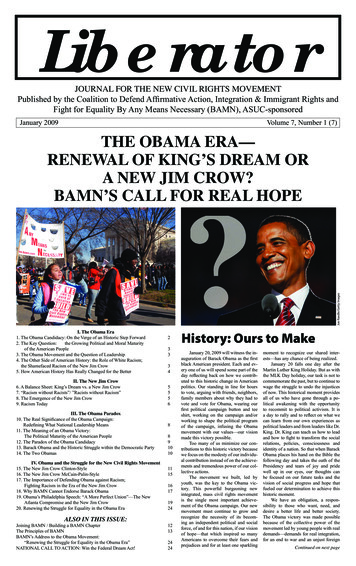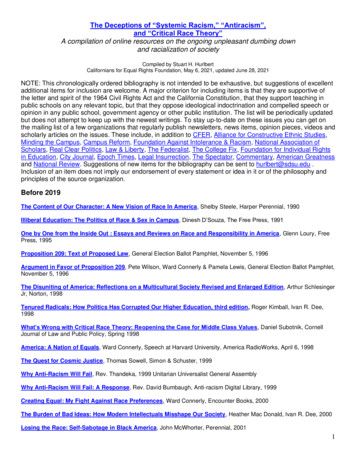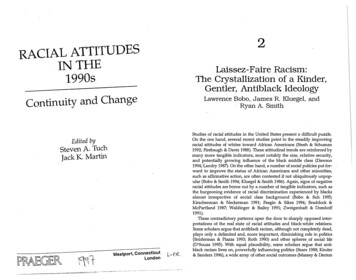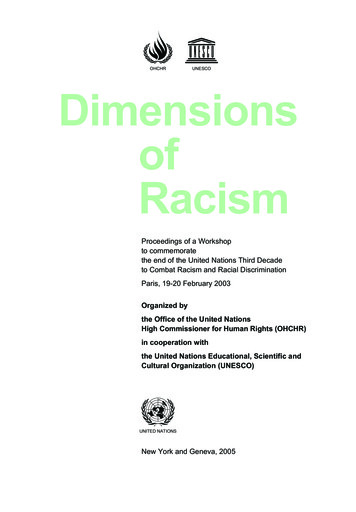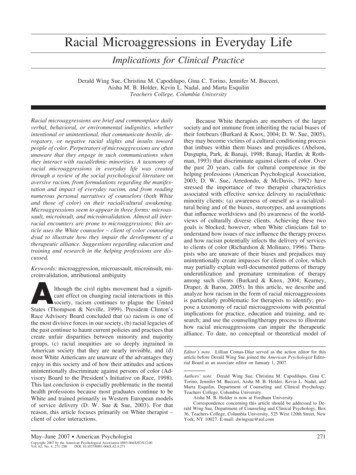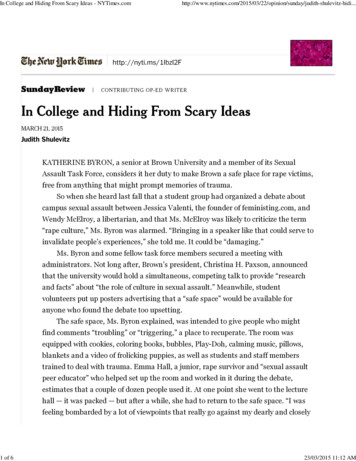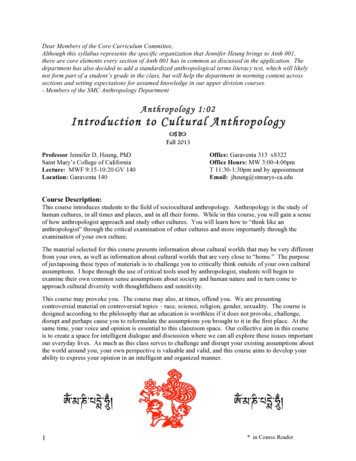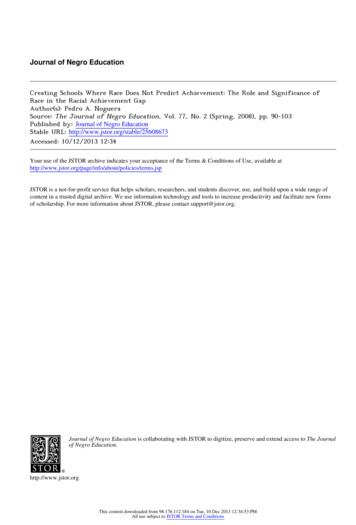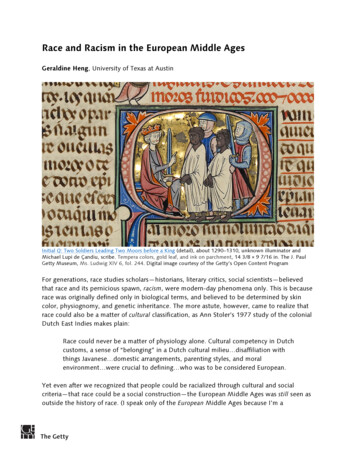
Transcription
Race and Racism in the European Middle AgesGeraldine Heng, University of Texas at AustinInitial Q: Two Soldiers Leading Two Moors before a King (detail), about 1290–1310, unknown illuminator andMichael Lupi de Çandiu, scribe. Tempera colors, gold leaf, and ink on parchment, 14 3/8 9 7/16 in. The J. PaulGetty Museum, Ms. Ludwig XIV 6, fol. 244. Digital image courtesy of the Getty’s Open Content ProgramFor generations, race studies scholars—historians, literary critics, social scientists—believedthat race and its pernicious spawn, racism, were modern-day phenomena only. This is becauserace was originally defined only in biological terms, and believed to be determined by skincolor, physiognomy, and genetic inheritance. The more astute, however, came to realize thatrace could also be a matter of cultural classification, as Ann Stoler’s 1977 study of the colonialDutch East Indies makes plain:Race could never be a matter of physiology alone. Cultural competency in Dutchcustoms, a sense of “belonging” in a Dutch cultural milieu disaffiliation withthings Javanese domestic arrangements, parenting styles, and moralenvironment were crucial to defining who was to be considered European.Yet even after we recognized that people could be racialized through cultural and socialcriteria—that race could be a social construction—the European Middle Ages was still seen asoutside the history of race. (I speak only of the European Middle Ages because I’m a
euromedievalist—it’s up to others to discuss race in Islamic, Jewish, Asian, African, andAmerican premodernities.)This meant that the atrocities of the medieval period—roughly 500 to 1500 CE—such as theperiodic exterminations of Jews in Europe, the demand that they mark their bodies and thebodies of their children with a large visible badge, the herding of Jews into specific towns inEngland to monitor their livelihoods, and the vilification of Jews for supposedly possessing afetid stench, a male menses, subhuman and bestial qualities, and a congenital need to ingestthe blood of Christian children whom they tortured and crucified to death: All these and morewere considered to be just premodern “prejudice” and not acts of racism.My book The Invention of Race in the European Middle Ages suggests that the exclusion of themedieval period from the history of race issues derives from an understanding of race that hasbeen overly influenced by the era of scientific racism (in the so-called “Age ofEnlightenment”), when science was the magisterial arbiter of racial classification.But today, in news media and public life, we see how religion also can function to classifypeople in absolute and fundamental ways—for instance, Muslims, who hail from a diversity ofethno-races and national origins, have been talked about as if their religion somehowidentified them as one homogenous people.The Invention of Race thus puts forward an understanding of race more apposite to our time,as well as to medieval time:“Race” is one of the primary names we have—a name we retain for thecommitments it recognizes—that is attached to a repeating tendency, of thegravest import, to demarcate human beings through differences among humansthat are selectively identified as absolute and fundamental, so as to distributepositions and powers differentially to human groups. In race-making, strategicessentialisms are posited and assigned through a variety of practices: Race is thusa structural relationship for the management of human differences, rather than asubstantive content.Instead of opposing premodern “prejudice” to modern racisms, we can then see the treatmentof medieval Jews—including their legalized murder by the state on the basis of communityrumors and lies—as racial acts, which today we might even call hate crimes, of a sanctionedand legalized kind. In this way, we would bear witness to the full meaning of events in themedieval past, and understand that racial thinking, racial practices, and racial phenomena canoccur before there was a vocabulary to name them for what they are.To discuss medieval race, I’ve scrutinized a wide range of evidence: art and statuary, maps,saints’ lives, state legislature, church laws, social institutions, popular beliefs, economic J. Paul Getty Trust. Licensed under a Creative Commons Attribution 4.0 International License (CC BY 4.0)2
relations, war, settlement and colonization, religious treatises, and many kinds of literature(travel accounts, ethnographies, romances, chronicles, letters, papal bulls, etc.).I’ve suggested that medieval England is the first racial state in the history of the West. Englishchurch and state laws produced surveillance, tagging, herding, incarceration, legal murder, andfinally, the expulsion of English Jews. A popular story of Jews killing Christian boys—whichbegan in England and spread throughout the continent—shifts in marked ways across acentury, told and retold to consolidate the communal identity of England as a nation unitedagainst Jews, who became an internal minority of perpetual outsiders.In 1215, Canon 68 of the Fourth Lateran Council installed racial law in the Latin West byordering Jews and Muslims to mark themselves off by a difference of dress. English laws andstatutes quickly elaborated this into a “badge of shame” and increasingly constricted thefreedom of Jewish subjects, till in 1275, the Statute of Jewry created residential enclaves—thebeginnings of the ghetto—by forbidding Jews from living among Christians. By 1290,parliamentary law drove Jews from England altogether, in their first permanent expulsion froma European country.Concomitantly, Muslims were turned into non-humans, with the renowned theologian Bernardof Clairvaux, who co-wrote the Rule for the Order of the Templars, announcing that the killingof a Muslims wasn’t actually homicide, but malicide—the extermination of incarnated evil, notthe killing of a person. Ingeniously, authors and theologians in Europe repeatedly calledMuslims Saracens—a made-up name that falsely claimed Muslims called themselves Saraceni topretend they were descended from Sara, Abraham’s legitimate wife, and not Hagar, herbondwoman, because of their shame—a story that characterized Muslims as liars, in the veryact of telling a lie about them.The extraterritorial incursions we call the Crusades even created an indispensable template forEurope’s later colonial empires of the modern eras, by creolizing the old template of Romancolonization. When Europeans later came to subjugate the populations of the world andspread new maritime empires, they came with the Book and the Sword—not like ancientRome, but like medieval Christendom.Even fellow Christians could be racialized: Gerald of Wales justified England’s invasion ofIreland in the twelfth century by depicting the Irish as a subhuman, savage, and bestial race—aracializing strategy in England’s colonial rule of Ireland that echoed from the medieval throughthe early modern period: Four centuries later, Edmund Spenser would repeat the samederogatory lies about the bestial, savage, inhuman Irish.Europeans, of course, knew of the existence of sub-Saharan Africans, whom they met onpilgrimage to Jerusalem, and in the trading ports of the Mediterranean. Thanks to Ethiopia’sChristianization in the fourth century, and Nubia’s in the sixth, pious Ethiopian priests served J. Paul Getty Trust. Licensed under a Creative Commons Attribution 4.0 International License (CC BY 4.0)3
at the Holy Sepulcher, alongside devout pilgrims from Africa. Yet sub-Saharan Africanscontinued to be depicted as the torturers of Christ and killers of John the Baptist in Europeanart. In literature, Africa invited fantasies of what the outside world could offer—treasure, sex,wealth, supremacy—if the West could only make the world more like Latin Christendom itself.And so, the patron saint of Magdeburg Cathedral, St. Maurice—a martyr venerated for athousand years—was suddenly depicted in 1220 as a black African: a way to make Africamobile and transportable to the heartlands of the Holy Roman Empire, where Africa’s hallowedpast of church fathers and holy ascetics could be recalled, displayed, and owned, in an era ofdisappointing crusading failure and Islamic dominance.Europeans also encountered Native Americans early in the eleventh century, whenGreenlanders and Icelanders founded settlements in North America. Icelandic sagas gleefullyshow the natives being bilked and cheated by the new settler-colonists in exploitative traderelations half a millennium before Columbus. The colonists even kidnap two native boys andabduct them back to Europe, forcibly Christianizing the children and teaching them Norse—anaccount of forced emigration that may explain why, among the races of the world, scientiststell us the C1e DNA gene element is shared only by Icelanders and Native Americans today.Medieval Europe also had an evolving relationship with the Mongol race. Studying Franciscanmissionary accounts, the famous narrative of Marco Polo and Rustichello of Pisa, Franciscanletters from China, the journey of Rabban Sauma, a monk of the Church of the East fromBeijing to Europe, and other travel narratives, will show you how Mongols transformed from ahideously monstrous alien race into an object of desire for the Latin West, once the MongolEmpire’s wealth, power, and vast resources became known.Mongols even offered the West a vision of modernity, of what that future might look like—with a postal express, disaster relief, social welfare, self-maintained census data collection bythe citizenry, independent women leaders, and paper money that was universally accepted.Unlike other races encountered by Latin Christendom—Jews, Muslims, Africans, NativeAmericans, and the Romani—Mongols were the only race representing absolute power, to afearful West.The medieval period was also a period of thriving international slavery. Caucasian slave womenin Al-Andalus (Islamic Spain) birthed heirs for Muslim rulers, so that for generations, theCaliphs of Córdoba were blond-haired, blue-eyed men, except for one (who was red-haired,and reportedly dyed his hair black to look more Arab). European human traffickers—especiallyItalian slavers—over the centuries resupplied the Mamluk dynasties of Egypt with Turkic andCaucasian slaves who became formidable military elites and Sultans, thus facilitating theultimate loss of all the crusader territories to the Mamluks, and ensuring Islamic domination ofthe Holy Lands. J. Paul Getty Trust. Licensed under a Creative Commons Attribution 4.0 International License (CC BY 4.0)4
Southeastern Europe too thrived on slavery: Dark-skinned migrants from India, later known tothe world as the Romani (“Gypsies”), became enslaved by religious houses and landowningelites in Wallachia and Moldavia, who subjugated the Romani for slave labor well into themodern era, making “Gypsy” the name of a slave race.In the end, it is the Romani—who consider themselves an ethnoracial group, despiteconsiderable internal heterogeneity among their peoples—who best personify the paradox ofrace and racial identification. Romani self-identification as a race, despite substantialdifferences in the composition of their populations across time and space, shows us whyracialization—by those outside, as well as by those who self-racialize—remains tenacious, wellinto the twenty-first century.Suggested Readings on Race and Racism in the European Middle AgesAkbari, Suzanne Conklin. Idols in the East: European Representations of Islam and the Orient,1100–1450. Ithaca: Cornell University Press, 2009.Bale, Anthony. The Jew in the Medieval Book: English Anti-Semitisms 1350–1500. Cambridge:Cambridge University Press, 2006.Biller, Peter. “Black Women in Medieval Scientific Thought.” Micrologus 13 (2005): 477–92. “Proto-racial Thought in Medieval Science.” The Origins of Racism in the West. 157–180. “Views of Jews from Paris around 1300: Christian or ‘Scientific’?” Christianity andJudaism. Ed. Diana Wood. Oxford: Blackwell, 1992. 187–207.Caviness, Madeline. “From the Self-Invention of the Whiteman in the Thirteenth Century toThe Good, the Bad, and the Ugly.” Different Visions: A Journal of New Perspectives onMedieval Art 1 (2008): 1–33. fCohen, Jeffrey Jerome. “Hybrids, Monsters, Borderlands: The Bodies of Gerald of Wales.” ThePostcolonial Middle Ages. Ed. Jeffrey Jerome Cohen. New York: St. Martins, 2000. 85–104.Devisse, Jean. The Image of the Black in Western Art: From the Early Christian Era to the “Age ofDiscovery.” Trans. William G. Ryan. Vol. 2 Pt. 1: From the Demonic Threat to theIncarnation of Sainthood. New York: William Morrow, 1979. Reissued with an introductionby Paul Kaplan and a preface by David Bindman and Henry Louis Gates, Cambridge, MA:Belknap Press of Harvard University Press, 2010.Eliav-Feldon, Miriam, Benjamin Isaac, and Joseph Ziegler, eds. The Origins of Racism in theWest. Cambridge: Cambridge University Press, 2009.Fraser, Angus. The Gypsies. Oxford: Blackwell, 1995. J. Paul Getty Trust. Licensed under a Creative Commons Attribution 4.0 International License (CC BY 4.0)5
Hancock, Ian. We Are the Romani People. Hatfield, Hertfordshire: University of HertfordshirePress, 2002.Hahn, Thomas, ed. Special Issue on Race and Ethnicity in the Middle Ages. Journal of Medievaland Early Modern Studies 31.1 (2001).Heng, Geraldine. Empire of Magic: Medieval Romance and the Politics of Cultural Fantasy. NewYork: Columbia University Press, 2003 (2004, 2012). The Invention of Race in the European Middle Ages. New York: Cambridge UniversityPress, 2018.Hsy, Jonathan and Julie Orlemanski, eds. “Race and Medieval Studies, a Partial Bibliography.”postmedieval 8.4 (2017): .1057/s41280-017-0072-0.pdfKaplan, Paul H. D. The Rise of the Black Magus in Western Art. Ann Arbor: UMI ResearchPress, 1985.Kruger, Steven F. “Conversion and Medieval Sexual, Religious, and Racial Categories.”Constructing Medieval Sexuality. Ed. Karma Lochrie, Peggy McCracken, and James A.Schultz. Minneapolis: University of Minnesota Press, 1997. 158–179.Lampert, Lisa. “Race, Periodicity, and the (Neo-) Middle Ages.” Modern Language Quarterly 65(2004): 392–421.Mastnak, Tomaz. Crusading Peace: Christendom, the Muslim World, and Western PoliticalOrder. Berkeley: University of California Press, 2002.Mellinkoff, Ruth. Outcasts: Signs of Otherness in Northern European Art of the Late MiddleAges. 2 vols. Berkeley: University of California Press, 1993.Patton, Pamela. Envisioning Others: Race, Color, and the Visual in Iberia and Latin America.Leiden: Brill, 2015.People of Color in European Art History. https://twitter.com/medievalpocRamey, Lynn T. Black Legacies: Race and the European Middle Ages. Gainesville: UniversityPress of Florida, 2014.Stacey, Robert C. “Anti-Semitism and the Medieval English State.” The Medieval State: EssaysPresented to James Campbell. Eds. J. R. Madicott and D. M. Palliser. London: Hambledon,2000. 163–177.Strickland, Debra Higgs. Saracens, Demons, and Jews: Making Monsters in Medieval Art.Princeton: Princeton University Press, 2003.Sturtevant, Paul, ed. Special Series on Race, Racism, and the Middle Ages, The PublicMedievalist. le-ages-toc/ J. Paul Getty Trust. Licensed under a Creative Commons Attribution 4.0 International License (CC BY 4.0)6
Tolan, John V. Saracens: Islam in the Medieval European Imagination. New York: ColumbiaUniversity Press, 2002. Sons of Ishmael: Muslims through European Eyes in the Middle Ages. Gainesville:University Press of Florida, 2008.Trachtenberg, Joshua. The Devil and the Jews: The Medieval Conception of the Jew and ItsRelation to Modern Antisemitism. New Haven: Yale University Press, 1943.Whitaker, Cord, ed. Special Issue on Making Race Matter in the Middle Ages, postmedieval6.1 (2015).Ziegler, Joseph. “Physiognomy, Science, and Proto-racism 1200–1500.” The Origins of Racismin the West. 181–99. J. Paul Getty Trust. Licensed under a Creative Commons Attribution 4.0 International License (CC BY 4.0)7
Race and Racism in the European Middle Ages Geraldine Heng, University of Texas at Austin Initial Q: Two Soldiers Leading Two Moors before a King (detail), about 1290–1310, unknown illuminator and Getty Museum, Ms. Ludwig XIV 6, fol. 244. D

